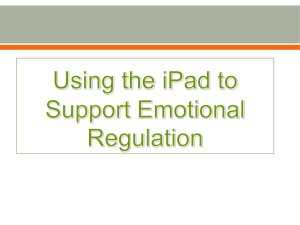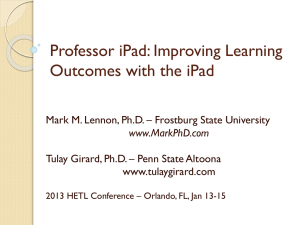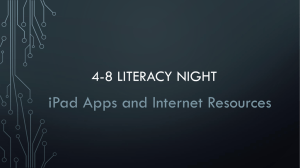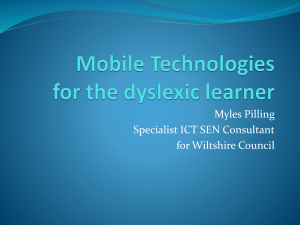Using iPad Apps to Engage Students in Critical Thinking
advertisement
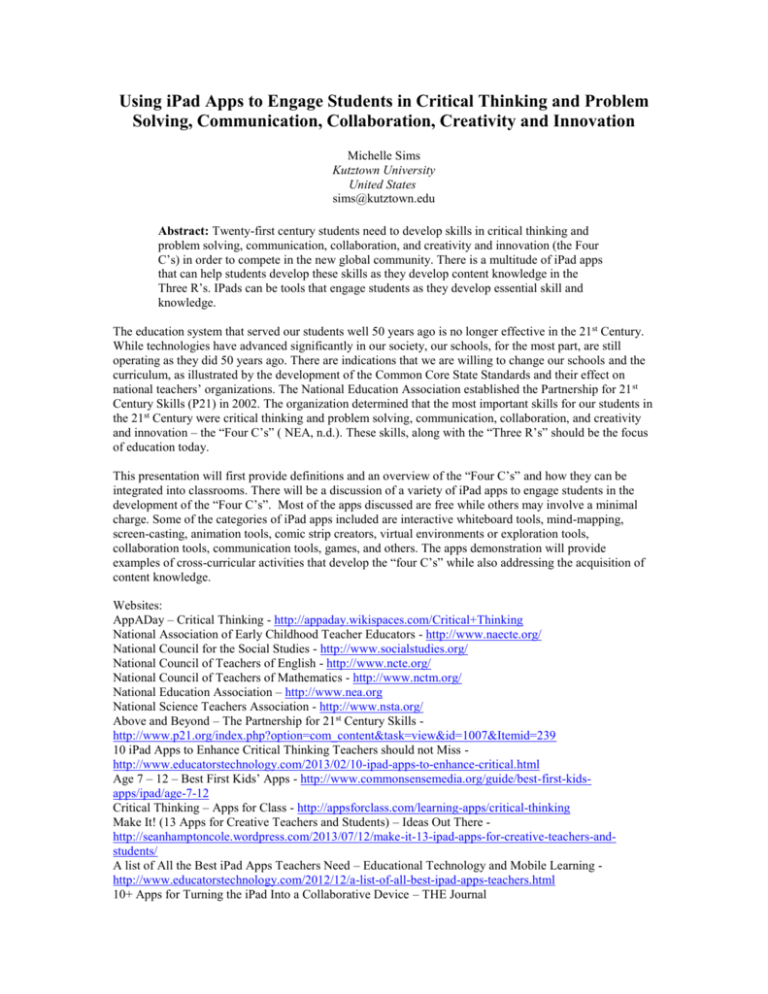
Using iPad Apps to Engage Students in Critical Thinking and Problem Solving, Communication, Collaboration, Creativity and Innovation Michelle Sims Kutztown University United States sims@kutztown.edu Abstract: Twenty-first century students need to develop skills in critical thinking and problem solving, communication, collaboration, and creativity and innovation (the Four C’s) in order to compete in the new global community. There is a multitude of iPad apps that can help students develop these skills as they develop content knowledge in the Three R’s. IPads can be tools that engage students as they develop essential skill and knowledge. The education system that served our students well 50 years ago is no longer effective in the 21st Century. While technologies have advanced significantly in our society, our schools, for the most part, are still operating as they did 50 years ago. There are indications that we are willing to change our schools and the curriculum, as illustrated by the development of the Common Core State Standards and their effect on national teachers’ organizations. The National Education Association established the Partnership for 21 st Century Skills (P21) in 2002. The organization determined that the most important skills for our students in the 21st Century were critical thinking and problem solving, communication, collaboration, and creativity and innovation – the “Four C’s” ( NEA, n.d.). These skills, along with the “Three R’s” should be the focus of education today. This presentation will first provide definitions and an overview of the “Four C’s” and how they can be integrated into classrooms. There will be a discussion of a variety of iPad apps to engage students in the development of the “Four C’s”. Most of the apps discussed are free while others may involve a minimal charge. Some of the categories of iPad apps included are interactive whiteboard tools, mind-mapping, screen-casting, animation tools, comic strip creators, virtual environments or exploration tools, collaboration tools, communication tools, games, and others. The apps demonstration will provide examples of cross-curricular activities that develop the “four C’s” while also addressing the acquisition of content knowledge. Websites: AppADay – Critical Thinking - http://appaday.wikispaces.com/Critical+Thinking National Association of Early Childhood Teacher Educators - http://www.naecte.org/ National Council for the Social Studies - http://www.socialstudies.org/ National Council of Teachers of English - http://www.ncte.org/ National Council of Teachers of Mathematics - http://www.nctm.org/ National Education Association – http://www.nea.org National Science Teachers Association - http://www.nsta.org/ Above and Beyond – The Partnership for 21st Century Skills http://www.p21.org/index.php?option=com_content&task=view&id=1007&Itemid=239 10 iPad Apps to Enhance Critical Thinking Teachers should not Miss http://www.educatorstechnology.com/2013/02/10-ipad-apps-to-enhance-critical.html Age 7 – 12 – Best First Kids’ Apps - http://www.commonsensemedia.org/guide/best-first-kidsapps/ipad/age-7-12 Critical Thinking – Apps for Class - http://appsforclass.com/learning-apps/critical-thinking Make It! (13 Apps for Creative Teachers and Students) – Ideas Out There http://seanhamptoncole.wordpress.com/2013/07/12/make-it-13-ipad-apps-for-creative-teachers-andstudents/ A list of All the Best iPad Apps Teachers Need – Educational Technology and Mobile Learning http://www.educatorstechnology.com/2012/12/a-list-of-all-best-ipad-apps-teachers.html 10+ Apps for Turning the iPad Into a Collaborative Device – THE Journal http://thejournal.com/articles/2013/05/08/10-apps-for-turning-the-ipad-into-a-collaborative-device.aspx K-5 iPad Apps for Analyzing: Part Four of Bloom’s Revised Taxonomy – http://www.edutopia.org/blog/ipad-apps-elementary-blooms-taxomony-analyzing-diane-darrow References: Darrow, D. (2011). K-5 iPad apps for analyzing: Part four of Bloom’s Revised Taxonomy. Edutopia. Retrieved January 9, 2013, from http://www.edutopia.org/blog/ipad-apps-elementary-blooms-taxomonyanalyzing-diane-darrow Gardner, H. (2007). Five minds for the future. Boston: Harvard Business School. National Education Association. (n.d.)Preparing 21st Century Students for a Global Society: An Educator’s Guide to the “Four C’s”. Retrieved on January 9, 2013, from http://www.nea.org/tools/52217.htm. Paul, R., and Elder, L. (2008). The thinker’s guide to critical and creative thinking. Retrieved on October 1, 2013, from http://dl4a.org/uploads/pdf/CCThink_6.12.08.pdf Tishman, Shari. (n.d.). Thinking dispositions: A new look at what it means to be a good thinker. Retrieved on October 1, 2013, from http://learnweb.harvard.edu/alps/thinking/docs/alumbull.pdf
